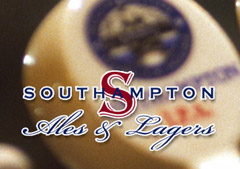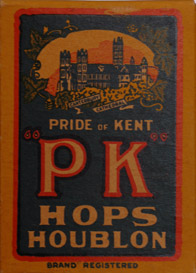Prepare your knee.
Pabst Brewing announces that it has entered into a strategic alliance with Southampton Bottling to market and distribute its award-winning line of craft-brewed ales and lagers.
Jerk.
Oh my God, what are they doing? Selling out.
Those last words are from Southampton brewmaster Phil Markowski, saying out loud what he knows many in the beer loving community are thinking.
 Let’s cut to the chase. Markowski is one of the most respected brewers in the country and many of the beers he’s brewed at Southampton Publick House in Long Island developed a cult following. They are beers of conviction (my words, not his).
Let’s cut to the chase. Markowski is one of the most respected brewers in the country and many of the beers he’s brewed at Southampton Publick House in Long Island developed a cult following. They are beers of conviction (my words, not his).
Whether you figure Pabst abandoned conviction in the 1870s by joining the rush to adjunct brewing, in 2001 when it closed its last brewery and became a marketing firm, or sometime between I’m comfortable saying that Pabst currently doesn’t sell many, perhaps any, beers of conviction. That changes when this deal closes during the first quarter of 2008.
To be clear, I’m not calling the myriad of brands (remember we’re talking about Pabst, Schlitz, Lone Star and a host of others) Pabst markets bad beers. They are well executed, which is why Pabst was honored as Large Brewing Company of the Year at the Great American Beer Festival in 2006 and 2007. Remember that what they choose to do they do well.
So what’s going to happen with the Southampton beers? Markowski discussed the future Friday while his car was on a ferry, taking him to his Connecticut home after he’d finished a day of brewing at the Publick House in Southampton. He lives pretty much equidistant, meaning 2½ hours, from the three breweries where he makes Southampton beers.
At Olde Saratoga Brewing in Saratoga Spring, N.Y., he supervises production of three year-round brands sold in six packs, as well as seasonal beers sold in 22-ounce bottles. At Sly Fox Brewing in Royersford, Pa., he brews beers packaged in 750ml corked bottles. And in Southampton he brews beer for the pub, with a part of a few batches sometimes ending up in bottles.
What changes? He won’t brew at Olde Saratoga anymore, because the brewery doesn’t have enough excess capacity. He’ll likely make Secret Ale, Double White Ale and perhaps IPA at the Lion Brewery in Pennsylvania, which is in the process of being sold. (Lew Bryson is the go-to guy for those updates). Nothing changes at the pub or with the 750s.
 “I intend to be on site for every brew indefinitely,” Markowski said.
“I intend to be on site for every brew indefinitely,” Markowski said.
“I have the intention of being totally hands on,” he said a little later. “There is no thought of changing the product or the integrity of the product.”
Those are words of conviction. He speaks just as assertively when it comes to contract brewing and batch size.
Arguments about contract brewing have been going on for more than 20 years. “I understand the roots of that (“contract isn’t the same as craft”) thinking, but I think that is changing,” Markowski said. “As the industry is growing up some of subjectivity is coming out of it. … It’s more, ‘How does it taste?'”
Remember the off-the-wall commercials that Miller ran 10 years ago featuring a fellow called Dick? One for Miller Genuine Draft told us, “It’s time to drink beer from vats the size of Rhode Island.” That pretty well epitomized a notion of micro versus macro that continues today.
“It’s less romantic, but the perception that you can’t make good beer on a large scale is wrong,” Markowski said. Then why aren’t the larger breweries winning medals in the GABF categories micros enter?
“They often become timid with a beer flavor profile,” Markowski said.
So here we are back discussing conviction. When the this deal was announced last week, Long Island wine blogger Lenn Thompson wrote:
… how many times have we seen terrific craft brews gobbled up by big brewers only to see the distinctive flavors disappear, resulting in watered down beers that are mere shadows of their former selves? I’m worried, but I guess we’ll see how this plays out.
Other than the Celis Brewery, which Miller literally ran into the ground, can you think of another small American brewery ruined when it was gobbled up? (And, to be clear, Southampton is not being gobbled.)
I may have forgotten one, but I can guarantee the list of smaller breweries that ran aground by underestimating beer drinkers’ interest in distinctive flavors is far longer.
It’s hard to overstate the importance of conviction.
 Ted Duchesne at
Ted Duchesne at  Think homebrewing is difficult? Here’s a recipe for Cottage Beer:
Think homebrewing is difficult? Here’s a recipe for Cottage Beer: I’m sorry, but beyond that I’m not prepared to connect the dots. I do know that this does not mean that Pabst will be brewing a saison. Anywhere. Anytime. Pabst doesn’t own a brewery. It has Pabst, Lone Star, Pearl, Ranier, Blatz, Schlitz and a raft of others brewed under contract.
I’m sorry, but beyond that I’m not prepared to connect the dots. I do know that this does not mean that Pabst will be brewing a saison. Anywhere. Anytime. Pabst doesn’t own a brewery. It has Pabst, Lone Star, Pearl, Ranier, Blatz, Schlitz and a raft of others brewed under contract.